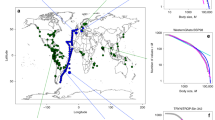Abstract
UsingEcopath, a trophic mass-balance modeling framework, we developed six models of a Canadian boreal forest food web centered around snowshoe hares, which have conspicuous 10-year population cycles. Detailed models of four phases of the cycle were parameterized with long-term population data for 12 vertebrate taxa. We also developed five other models that, instead of observed data, used parameter values derived from standard assumptions. Specifically, in the basic model, production was assumed to equal adult mortality, feeding rates were assumed to be allometric, and biomass was assumed to be constant. In the actual production, functional response, and biomass change models, each of these assumed values from the basic model was replaced individually by field data. Finally, constant biomass models included actual production by all species and functional responses of mammalian predators and revealed the proportion of herbivore production used by species at higher trophic levels. By comparing these models, we show that detailed information on densities and demographics was crucial to constructing models that captured dynamic aspects of the food web. These detailed models reinforced an emerging picture of the causes and consequences of the snowshoe hare cycle. The snowshoe hare decline and low phases were coincident with times when per capita production was relatively low and predation pressure high. At these times, ecotrophic efficiencies (EE) suggest there was little production that remained unconsumed by predators. The importance of both production and consumption implies that bottom–up and top–down factors interacted to cause the cycle. EEs of other herbivores (ground squirrels, red squirrels, small mammals, small birds, grouse) were generally low, suggesting weak top–down effects. Predation rates on these “alternative” prey, except ground squirrels, were highest when predators were abundant, not when hares were rare; consequently, any top–down effects reflected predator biomass and were not a function of diet composition or functional responses. Finally, several predators (lynx, coyotes, great-horned owls) showed clear bottom–up regulation, reproducing only when prey exceeded threshold densities. Taken altogether, these results demonstrate that ecosystem models parameterized by population data can describe the dynamics of nonequilibrial systems, but only when detailed information is available for the species modeled.
Similar content being viewed by others
Author information
Authors and Affiliations
Additional information
Received 30 November 2000; Accepted 6 September 2001.
Rights and permissions
About this article
Cite this article
Ruesink, J., Hodges, K. & Krebs, C. Mass-Balance Analyses of Boreal Forest Population Cycles: Merging Demographic and Ecosystem Approaches. Ecosystems 5, 138–158 (2002). https://doi.org/10.1007/s10021-001-0061-9
Issue Date:
DOI: https://doi.org/10.1007/s10021-001-0061-9




